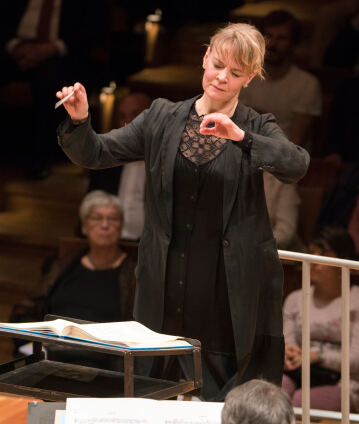Susanna Mälkki and Gil Shaham

The works of this evening with Susanna Mälkki look both back to the past and forward to the future. For example, Béla Bartók’s Second Violin Concerto, with soloist Gil Shaham, is in the tradition of Beethoven and Brahms but also experiments with the twelve-tone technique. Jean Sibelius’s Second Symphony, on the other hand, combines echoes of Tchaikovsky with innovative form, while Ferruccio Busoni’s Tanz-Walzer conjures up the atmosphere of a coffee house.
Ferruccio Busoni and the Berliner Philharmoniker enjoyed a long artistic partnership: After the German-Italian made his debut with the orchestra on 11 February 1891 playing Beethoven’s Fifth Piano Concerto, he was included in concert programmes on a regular basis. For seven years, the composer, conductor and pianist organised a concert series with the Philharmoniker which featured only new music and rarities of the repertoire: “The composers,” as it said in an announcement in the Signale für die musikalische Welt, “will conduct their respective works, and only when this is not possible does Busoni intend to take over the direction himself”. The ambitious series started on 8 November 1902 with Edward Elgar’s The Dream of Gerontius, and until 1909, it remained a gathering place for the contemporary avant-garde. Of course, Busoni also presented the Berlin public with his own works which were represented in the musical life of the capital on a regular basis even after his philharmonic new music series came to an end: The Berliner Philharmoniker gave the premiere of his Tanz-Walzer op. 53 on 13 January 1921. And it is with this work, inspired “by the sounds of a waltz wafting from the interior of a coffee house” (Busoni), that Susanna Mälkki starts off her guest appearance conducting the Berliner Philharmoniker.
The Finnish conductor, regarded as a specialist in contemporary music, then turns to Béla Bartók’s Second Violin Concerto, whose first movement’s main theme is characterised by lyricism and broadly sweeping melodic lines. The contrasting second subject is based on a twelve-tone row which, however, (similar to the Violin Concerto by Alban Berg) has distinct tonal characteristics. The soloist is none other than Gil Shaham, who has often been compared to the likes of Menuhin, Heifetz and Perlman and counts himself among the declared admirers of Bartók’s music: “The music is full of power, but is also sensitive, it is serious and full of humour, revolutionary and classic. [...] Whether adapting folk melodies, or composing in the twelve-tone technique, Bartók’s style and artistic judgement constantly inspire me.”
The symphonic main work of the evening is Jean Sibelius’s Second Symphony, about which Karl Flodin, the leading Finnish music critic of the late 19th century, enthusiastically wrote: “[...] the more one listens to this brilliant work, the more powerful one finds its contours, the more profound its spiritual content and the more incisive the indicators that provide for the proper understanding of the composition.”
© 2017 Berlin Phil Media GmbH
Related interviews
Artists
Our recommendations
- Elgar’s Violin Concerto with Gil Shaham and David Zinman
- Claudio Abbado conducts music from “Carmen” at the 1997 New Year’s Eve Concert
- Zubin Mehta conducts Saint-Saëns’s “Organ Symphony”
- 2002 Europakonzert from Palermo with Claudio Abbado and Gil Shaham
- Susanna Mälkki conducts “Bluebeard’s Castle”
- The Berlin Phil Series: An American in Berlin